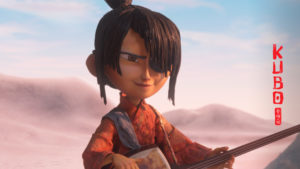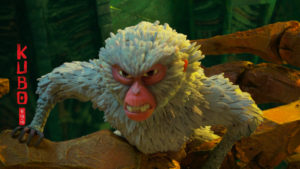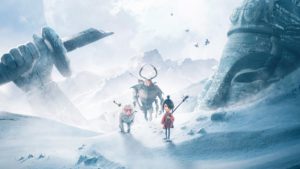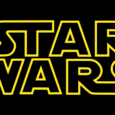Even before its release, Kubo and the Two Strings was a special movie. Laika Entertainment, who previously delivered films ParaNorman, Coraline, and The Boxtrolls, earned every iota of anticipation. Consistently positive receptions from critics and moviegoers alike act as the evidence. Additionally, those 3 aforementioned projects were nominated for the Best Animated Feature Academy Award in their respective years. Knowing Laika’s visual and storytelling prowess, Kubo logically became a must-see summer 2016 movie for me.
Unlike other kids in his village, Kubo (voiced by Art Parkinson) is a youthful one-eyed street-performing storyteller. He uses magic to manipulate paper into a variety of moving origami shapes while reciting samurai adventures. Before night falls, Kubo journeys back home to care for his ill mother, using his busking money to pay for their nourishment. Kubo yearns for adventure outside of his stories, but accepts the importance of his responsibility to his mother.
One evening, Kubo mistakenly stays out too late, and two supernatural, terrifying-looking sisters (voiced by Rooney Mara) confront him. These sisters work for our main villain, the Moon King (voiced by Ralph Fiennes). The King stakes some sort of claim on Kubo since our protagonist’s birth. Forced out of his village for his own safety, Kubo starts a road trip to collect artifacts that can protect him from the King. Along the way, new friends Monkey (voiced by Charlize Theron) and Beetle (voiced by Matthew McConaughey, for some reason) join our hero in his quest.
Expanding on those characters, Matthew McConaughey gives a voice acting performance to a samurai Beetle. To me, the Texan twang and charm is an odd choice for a samurai of any species. However, I’m more than willing to overlook it considering what works in the movie’s favor. An example is Charlize Theron, who brings much of the picture’s humor with her deadpan delivery as the character Monkey. Furthermore, Kubo, Monkey, and Beetle display strong chemistry throughout, which can be credited to the writing as much as the voice acting.
The writing also pays tribute to Japanese folklore, which is retold in fresh ways here. I’m certainly not educated enough on said folklore to validate what’s true or not, but it’s definitely compelling. Moreover, the writers authored wholly fulfilling character arcs. The Monkey’s true intentions unravel in gratifying ways. The Beetle finds the sense of purpose he’d once lost. Kubo’s quest includes an emotional side dealing with bravery in the face of grief. Tears in your eyes are a near-guarantee as the end-credits roll.
Kubo and the Two Strings shines with not only its completely unique story, but its visuals. Laika and director Travis Knight designed each environment and character so meticulously. Whether an underwater sequence or an ancient samurai temple, it’s all carefully hand-crafted. Laika has an innate ability to convey human emotion using otherwise lifeless objects. The action scenes are no exception. In Kubo, you’ll find some of 2016’s best designed action in a movie, animated or not.
Another commendable aspect of Kubo and the Two Strings is its use of its music. As expected, the melodies contain a Japanese influence, and it’s well-blended. More compelling is the structure of the score. During the epic battle sequences in the 3rd act, the composition’s rise and fall aids in immersing you completely into this movie.
All in all, Kubo and the Two Strings is a near-perfect movie-going experience. The thrills, story, emotional weight, and amazing visuals balance each other effectively, making Kubo a filmic rarity in 2016. Laika continues to make a name for themselves in the world of animation, but they’re still clamoring for bigger audiences. Perhaps the specific animation style or the deeper stories prevent Laika’s movies from becoming box office phenomenons. Nonetheless, in the same year as Finding Dory and Secret Life of Pets, Kubo is not only the best animated cinematic offerings of the year so far, but one of 2016’s best films – period.
Grade: A-













